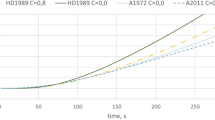Abstract
A computer program, LAVENT, is now available which computes the heating of fusible links due to the presence of a ceiling jet imbedded in an upper layer. An important new feature in this program is that the two-dimensional structure of the ceiling jet is taken into account such that the location of the link beneath the ceiling plays a role in the response of the link. The links can be used to activate ceiling vents such that the effect of venting the upper layer on the ceiling jet may be studied. Additional applications would include the study of upper layer containment through the use of a combination of draft curtains and ceiling vents. The geometry modeled by the program is that of a large compartment enclosed by a combination of walls and draft curtains.
Similar content being viewed by others
References
Alpert, R. L., “Calculation of the Response Time of Ceiling-Mounted Fire Detectors,”Fire Technology,8, pp. 181–195 (1972).
Evans, D. D. and Stroup, D. W., “Methods to Calculate the Response Time of Heat and Smoke Detectors Installed Below Large Unobstructed Ceilings,”Fire Technology,22, pp. 54–65 (1986).
Hinkley, P. L., “The Effect of Smoke Venting on the Operation of Sprinklers Subsequent to the First,”Fire Safety Journal,14, pp. 221–240 (1989).
Cooper, L. Y., “Estimating the Environment and the Response of Sprinkler Links in Compartment Fires with Draft Curtains and Fusible Link-Actuated Ceiling Vents—Theory,”Fire Safety Journal,16, pp. 137–163 (1990).
Davis, William D. and Cooper, Leonard Y., “Estimating the Environment and the Response of Sprinkler Links in Compartment Fires with Draft Curtains and Fusible-Link-Actuated Ceiling Vents — Part II: User Guide for the Computer Code LAVENT,” NISTIR 89-4122, National Institute of Standards and Technology, Gaithersburg, MD (August 1989).
Heskestad, G., “Engineering Relations for Fire Plumes,”Fire Safety Journal,7, pp. 25–32 (1984).
Emmons, H. W., “The Flow of Gases Through Vents,” Harvard University Home Fire Project Technical Report No. 75 (March 1987).
Cooper, L. Y. and Woodhouse, A. W., “The Buoyant Plume-Driven Adiabatic Ceiling Temperature Revisited,”Journal of Heat Transfer,108, pp. 822–826 (1986).
Yousef, W. W., Tarasuk, J. D., and McKeen, W. J., “Free Convection Heat Transfer From Upward-Facing, Isothermal, Horizontal Surfaces,”Journal of Heat Transfer,104, pp. 493–499 (1982).
Ozisik, M. Necati,Heat Conduction, John Wiley and Sons, pp. 501–503 (1980).
Cooper, L. Y., “Ceiling Jet-Driven Wall Flows in Compartment Fires,”Combust. Sci. and Tech.,62, pp. 285–296 (1988).
Heskestad, G. and Smith, H. F., “Investigation of a New Sprinkler Sensitivity Approval Test: The Plunge Test,” Technical Report Serial No. 22485, RC 76-T-SO, Factory Mutual Research Corporation, Norwood, MA (1976).
Author information
Authors and Affiliations
Rights and permissions
About this article
Cite this article
Davis, W.D., Cooper, L.Y. A computer model for estimating the response of sprinkler links to compartment fires with draft curtains and fusible link-actuated ceiling vents. Fire Technol 27, 113–127 (1991). https://doi.org/10.1007/BF01470863
Issue Date:
DOI: https://doi.org/10.1007/BF01470863




